
CHAFFERS SIDING[Source: Alan Young]
From 1876 until 1991 Chaffers Siding Cabin stood at the Barkerhouse Road level crossing ¾- mile south-west of Bott Lane Halt. Between this cabin and the halt was the extensive Nelson Mineral Yard with a signal box that operated from 1904 (when the yard opened) until 1971. Chaffers Siding Cabin – the name carried by the signal box – was opened in 1876. It was a Saxby & Farmer Type 8 brick-built structure containing an S&F frame of unknown leverage. In 1904 an LYR 24-lever frame replaced the original one when the loop from Nelson Mineral Yard was built. In 1971, following the closure of the railway beyond Colne, the line was singled from Chaffers Siding to the Colne terminus and ‘One Train Working’ commenced, with a Train Staff; it was probably at this time that the frame was reduced to 20 levers. A small wooden platform and handrail were added on which the signalman could stand to deliver and receive the staff. From 7 December 1986 what had become the Colne Branch was operated as single track to Gannow Junction (Rose Grove) at which time Chaffers Siding Cabin ceased to be a block post and was reduced to the status of a gate box. By the end of December the first few yards of the former down line had been lifted at Chaffers Siding. The level crossing was converted to ‘trainman’ operation on 20 March 1991 and Chaffers Siding Cabin closed and was swiftly demolished. The footbridge at the level crossing was dismantled at the same time. Fortunately Denis Parker took the accompanying series of photographs in February-March 1991 immediately before, during and after the changes at Chaffers Siding. ACKNOWLEDGEMENTS
BIBLIOGRAPHY:
See also Catlow Quarries (feature) Chaffers Siding Gallery: 1 c1900 - February 1991 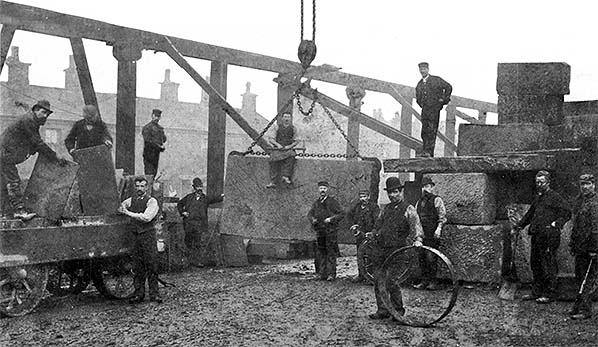 This photo shows the yard between Catlow Stone Works and Chaffers Siding in Nelson, looking north-west with Chapel Street in the background. Although undated it probably was taken circa 1900. Catlow Quarries, about 1½ miles away on the edge of the moors, produced sandstone which could be shaped into excellent building stone; one of the workers is sitting on a huge slab of shaped stone which is hanging from the jib of the travelling crane whose supporting rail crosses the photograph. Other large blocks of shaped stone are seen to the right. The cart appears to be loaded with flagstones, another product of Catlow, possibly for dispatch to some building site in the rapidly expanding town.
Photo from former Nelson Local History Society courtesy of Marilyn Metcalfe 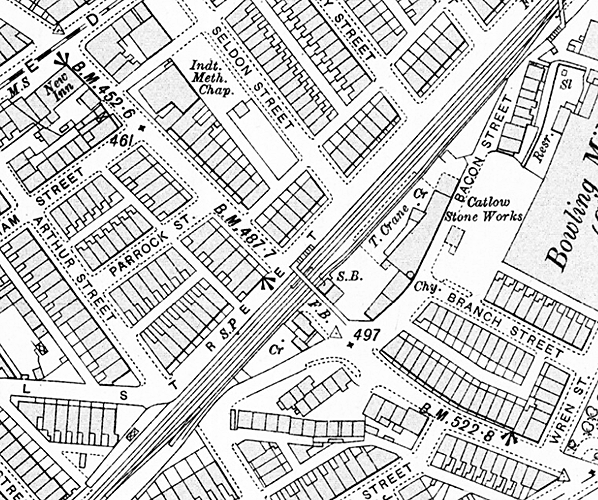
1912 1: 2,500 OS map. In 1912 the level crossing on Barkerhouse Road, Nelson, is accompanied by Chaffers Siding Cabin (S.B.) and a footbridge immediately north-east. Chaffers Siding is between the running lines and Catlow Stone Works. The stone from Catlow Quarries, about 1½ miles to the south-east was conveyed to the processing works via Barkerhouse Road.
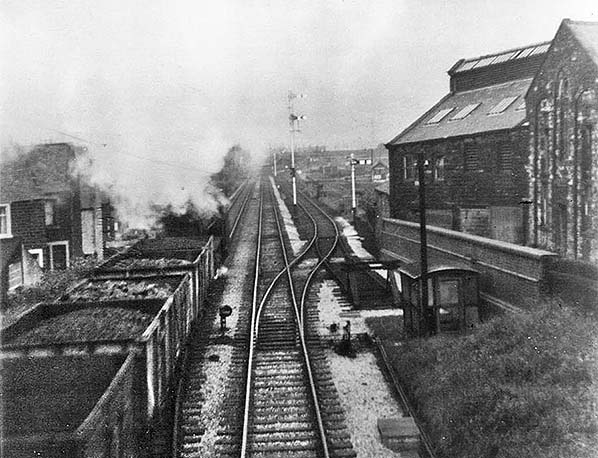 Looking north-east from the footbridge between Bacon Street and Chapel Street, Nelson c1960. Chaffers Siding Cabin and Barkerhouse Road level crossing are about 160yd behind the camera; Nelson mineral yard is ahead. A down mineral train is hauled by ex-LMS ‘Black Five’ 4-6-0 No.45216 built by Armstrong Whitworth in 1935 and withdrawn from 24B, Rose Grove circa February 1966. Looking north-east from the footbridge between Bacon Street and Chapel Street, Nelson c1960. Chaffers Siding Cabin and Barkerhouse Road level crossing are about 160yd behind the camera; Nelson mineral yard is ahead. A down mineral train is hauled by ex-LMS ‘Black Five’ 4-6-0 No.45216 built by Armstrong Whitworth in 1935 and withdrawn from 24B, Rose Grove circa February 1966.Photo by Brian Smith from his Flickr photostream 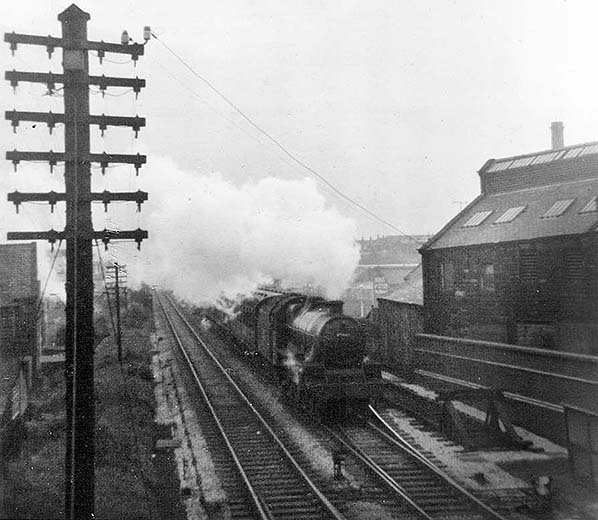 Looking north-east from the footbridge between Bacon Street and Chapel Street, Nelson c1960. Chaffers Siding Cabin and level crossing are about 160yd behind the camera; Nelson mineral yard is ahead. Ex-LMS Jubilee class 4-6-0 No.45561 Vernon is hauling an up passenger train towards Nelson.The loco was built at the LMS Derby Works in December 1934 and was withdrawn from 20A, Leeds Holbeck shed, circa May 1965.
Photo by Brian Smith from his Flickr photostream 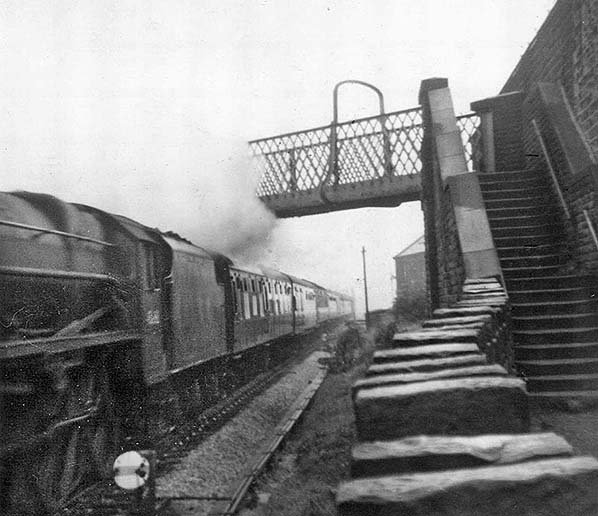
Looking north-east towards the footbridge between Bacon Street and Chapel Street, Nelson, circa 1960. Chaffers Siding Cabin and level crossing are about 160yd behind the camera. This footbridge is thought to have been demolished in the early 1990s. An unidentified loco is hauling an up passenger train.
Photo by Brian Smith from his Flickr photostream 
Looking south-west from a DMU passing Chaffers Siding Cabin and Barkerhouse Road level crossing in 1974. By this date the line between here and Colne has been singled and the double-tracks begin immediately beyond the crossing. J & D Ellison’s works, left, is a rare example of a brick building in the central area of Nelson – it looks as if it has escaped from Rochdale! – as most of Nelson’s buildings were constructed of local sandstone, much of the stone having been quarried at Chaffer’s Catlow Quarries. The building would soon be demolished with housing built on its site.
Photo by Ian Dinmore 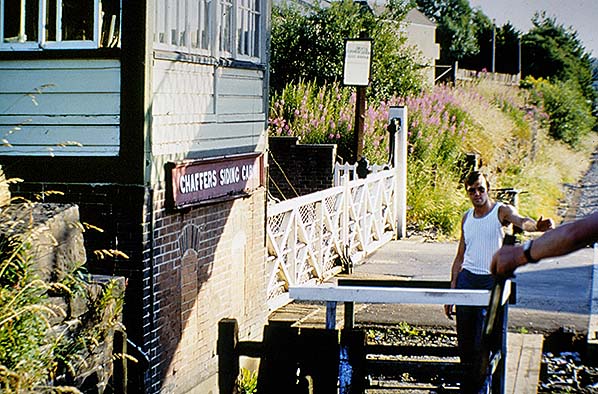
On 23 July 1984 the single-line staff is about to be received from the signalman at Chaffers Siding Cabin, Nelson. The DMU is about to leave the single-line section from Colne, and double tracks begin just beyond Barkerhouse Road level crossing.
Photo by Alan Young  Chaffers Siding Cabin, Nelson, looking south-east in September 1986. The Saxby & Farmer Type 8 brick-built structure containing an S&F frame of unknown leverage was opened in 1876. In 1904 an LYR 24-lever frame replaced the original one when the loop from Nelson Mineral Yard was built. Why the Lancashire & Yorkshire Railway called some of its signal boxes ‘cabin’ is not known. The footbridge adjacent to Barkerhouse Road level crossing is seen to the right.
Photo by Alan Young 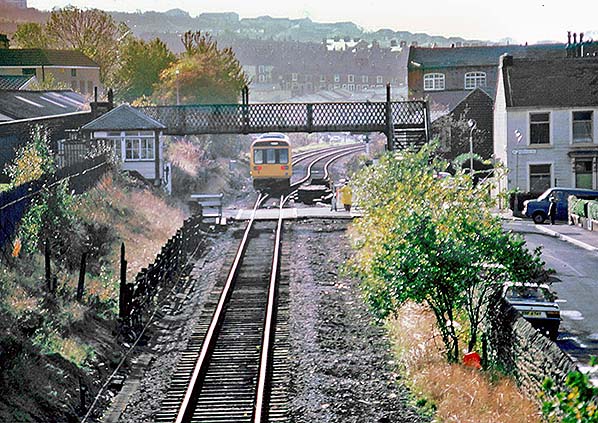
On 30 October 1986 a Class 142 ‘Pacer’ DMU from Colne has passed Chaffers Siding Cabin and Barkerhouse Road level crossing and is entering the double-track section that continues through Nelson station and all the way to Gannow Junction (Rose Grove) and Preston. A small platform has been built in front of the cabin where the signalman can stand when handling the single-line staff. The signalman doubles as gatekeeper, and he can be seen in his hi-vis coat closing the wooden gates, which are still of a traditional design. Five weeks later single-line working began on the route ahead as far as Gannow Junction. Until about 1930 Chaffers Siding ran in the gap between the running line and the signal cabin and continued over the level crossing; it served the stone processing works, formerly off the photo to the left, to which sandstone was delivered from Catlow Quarries. This photo, and the next, were taken from the footbridge between Bacon Street and Chapel Street, which has
now been removed. Photo
by Alan Young
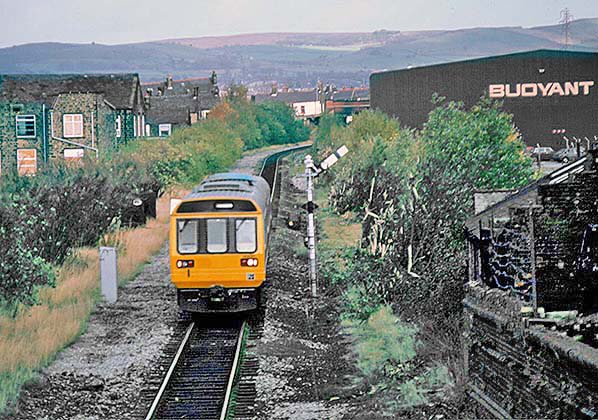
On 30 October 1986 a Class 142 ‘Pacer’ from Colne is approaching Chaffers Siding and Barkerhouse Road level crossing, Nelson, where the route becomes double track. The signal guarding the crossing and operated by Chaffers Siding Cabin is in the off (route clear) position. Until 1971 the route ahead was double track and Nelson Mineral Yard with its many sidings was located on the near side of Walton Lane bridge (seen in the distance). Forty years earlier there was a third line, to the right; this was Chaffers Siding which served the adjacent Catlow Stone Works where sandstone from Catlow Quarries was cut and shaped prior to distribution by rail and road.
Photo by Alan Young 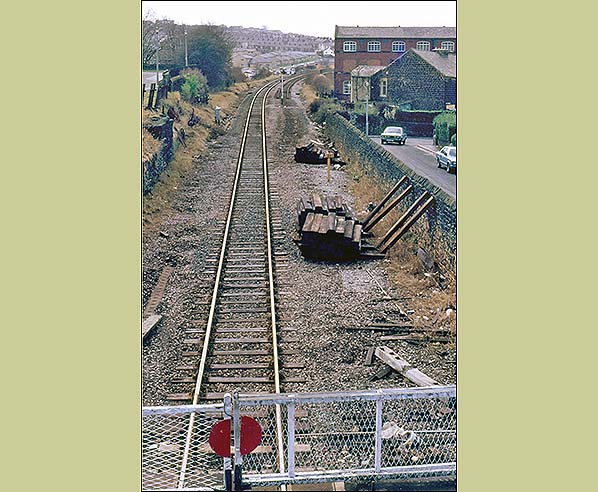
Looking south-west from the footbridge at Chaffers Siding Cabin and Barkerhouse Road level crossing, Nelson, on 31 December 1986. Three weeks earlier the route ahead was reduced to single-line operation and a few yards of the down track has been recovered with sleepers dumped and awaiting collection. The signal protecting the level crossing has been relocated on the site of the down line to make it more clearly visible to trains approaching on the curve from Nelson station. Chaffers Siding Cabin has several years of life ahead as a gate box.
Photo by Alan Young 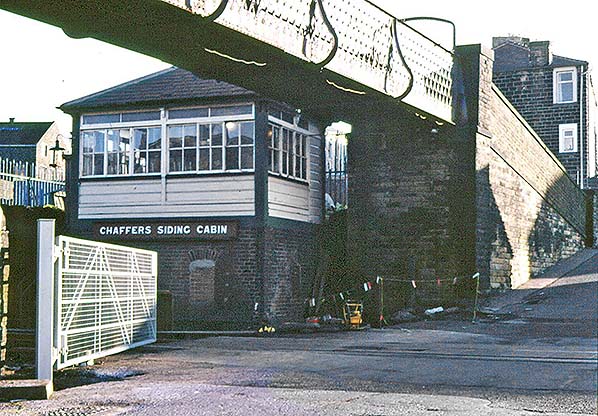 Chaffers Siding Cabin seen on 6 December 1987 from Barkerhouse Road level crossing. The traditional wooden gate has just been replaced with one made of metal, still without a red warning disk. The gate on the opposite side of the line has yet to be hung. At this stage the cabin is operating as a gate box, and the gates are manually operated. The cabin nameplate is of interest, dating from LYR years (pre-1923) and still painted in BR London Midland Region colours despite BR’s ‘Corporate Identity’ black-and-white signage having been policy for 23 years. There is only one train per hour in each direction but a footbridge is retained for the few members of the public who might bother to use it.
Photo by Alan Young 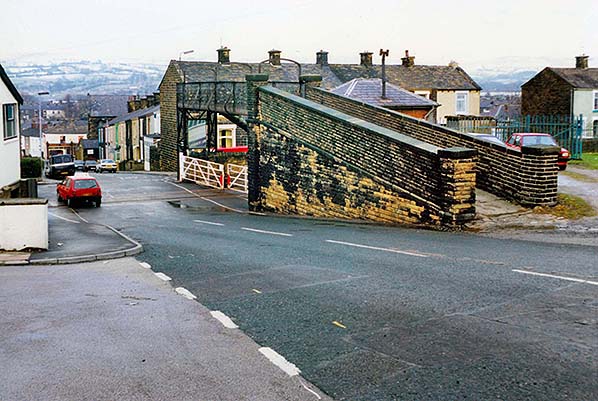
In February 1991, looking north, the level crossing on Barkerhouse Road, Nelson, has new (four-year-old) gates, complete with red warning disks. The footbridge and Chaffers Siding Cabin are still in place; the cabin’s hipped roof and tall chimney are visible beyond the stone walls of the ramp up to the bridge. The terraced houses on Chapel Street (right) can be seen on the c1900 photo of the stone works’ yard.
Photo
by Denis Parker
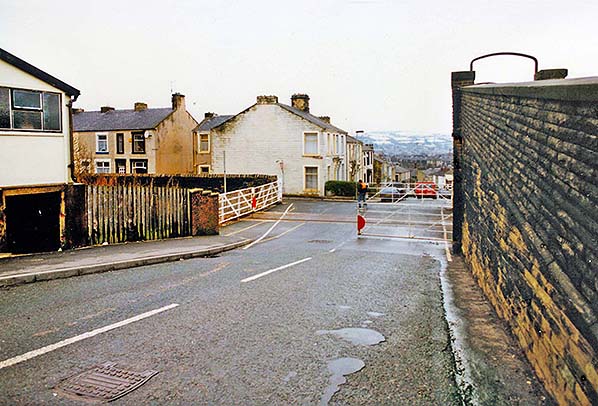
Looking north-west down Barkerhouse Road in February 1991. The gatekeeper is opening the level crossing gates across the single-track railway between Nelson and Colne. The wall on the right carries the ramp up to the footbridge which crosses the railway; access to the opposite side of the bridge is by means of a staircase.
Photo by Denis Parker 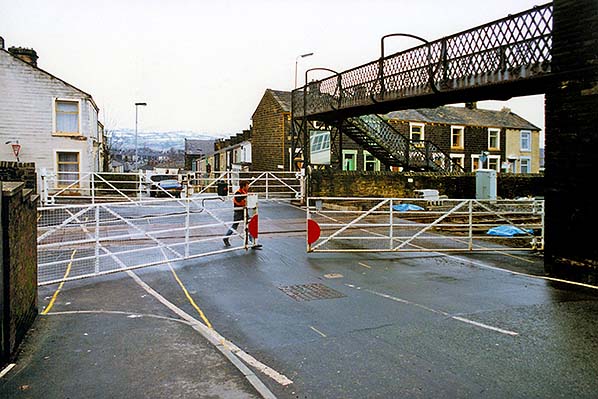 Looking north over Barkerhouse Road level crossing as the gatekeeper is closing the gates across the single-track railway between Nelson and Colne. This is one of a series of photos which record the closure of the gate box named Chaffers Siding Cabin (off the picture to the right), the removal of the footbridge and the conversion of the crossing to trainman operation. Looking north over Barkerhouse Road level crossing as the gatekeeper is closing the gates across the single-track railway between Nelson and Colne. This is one of a series of photos which record the closure of the gate box named Chaffers Siding Cabin (off the picture to the right), the removal of the footbridge and the conversion of the crossing to trainman operation.Photo by Denis Parker Click here for Chaffers Siding Gallery2: February 1991 - March 1991
 Home Page Home Page
|
